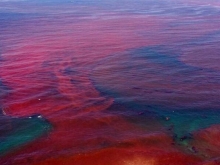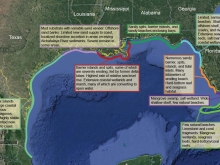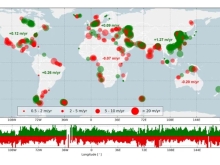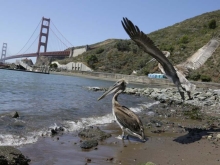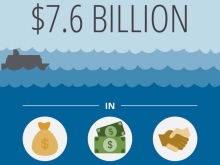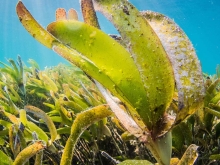What Is A Harmful Algal Bloom?
Harmful algal blooms, or HABs, occur when colonies of algae - simple plants that live in the sea and freshwater - grow out of control and produce toxic or harmful effects on people, fish, shellfish, marine mammals and birds. The human illnesses caused by HABs, though rare, can be debilitating or even fatal. Ranging from microscopic, single-celled organisms to large seaweeds, algae are simple plants that form the base of food webs. Sometimes, however, their roles are more sinister.
Understanding The Long-Term Evolution Of The Coupled Natural-Human Coastal System: The Future Of The U.S. Gulf Coast
The U.S. Gulf of Mexico Coast...provides a valuable setting to study deeply connected natural and human interactions and feedbacks that have led to a complex, interconnected coastal system. The physical landscape in the region has changed significantly due to broad-scale, long-term processes such as coastal subsidence and river sediment deposition, as well as short-term episodic events such as hurricanes. Modifications from human activities, including building levees and canals and constructing buildings and roads, have left their own imprint on the natural landscape. ...
The State Of The World's Beaches
Coastal zones constitute one of the most heavily populated and developed land zones in the world. Despite the utility and economic benefits that coasts provide, there is no reliable global-scale assessment of historical shoreline change trends. Here, via the use of freely available optical satellite images captured since 1984, in conjunction with sophisticated image interrogation and analysis methods, we present a global-scale assessment of the occurrence of sandy beaches and rates of shoreline change therein...
The Challenge Of Tracking Nutrient Pollution 2,300 Miles
Nitrogen and phosphorus are essential nutrients - yet too much of a good thing is not always a good thing. Scientists are investigating nutrient pollution down the Mississippi River. Each spring, water flows approximately 2,300 miles down the Mississippi River, beginning its journey at Lake Itasca in northern Minnesota and emptying into the Gulf of Mexico. Along the way, streams and rivers accumulate nutrients that run off the land and into the waterways, and eventually these nutrients enter the Gulf of Mexico.
Taking Steps Together On Equity & Climate Change: A Report By And For New Orleanians
This report is about how we live in New Orleans and the steps we can take to achieve equity through citywide action on climate change. In our city, African Americans, other people of color, low income families and individuals, the elderly and youth face various forms of inequity and are also vulnerable to the impacts of climate change.
The Biggest Likely Source Of Microplastics In California Coastal Waters? Our Car Tires
Driving is not just an air pollution and climate change problem - turns out, it just might be the largest contributor of microplastics in California coastal waters. That is one of many new findings, released Wednesday, from the most comprehensive study to date on microplastics in California.
The Fact Of Restoring The Louisiana Coast
On average, a football field of land disappears into the Gulf of Mexico every 100 minutes. Over thousands of years, the Mississippi River carried sediment to the Louisiana coastline, building up marshes, wetlands and new land. But today, because of canals and levees that constrict and confine the path of the river, the sediment cannot reach the delta to replenish the eroding wetlands.
Since the 1930s, Louisiana has lost close to 2,000 square miles of wetlands, an area roughly the size of Delaware.
Submerged Aquatic Vegetation: A Habitat Worth Sav-Ing
Submerged aquatic vegetation is one of the most productive fish habitats on earth. We work to protect this important habitat, ensuring that it remains healthy and has a chance to thrive.
Submerged Aquatic Vegetation Habitats Store Significant Amounts Of Organic Carbon In Coastal Louisiana
The ability of natural ecosystems to sequester significant amounts of organic carbon provides a good example of an ecosystem service that can be used in climate mitigation programs on local and regional scales. These mitigation programs may reduce the potential impact of increasing carbon dioxide concentrations in the atmosphere that are directly and indirectly driving climate change.
Pagination
- Page 1
- Next page
